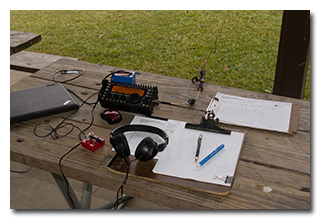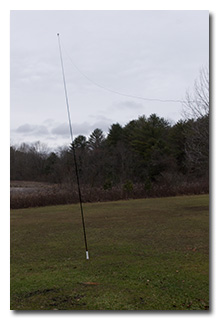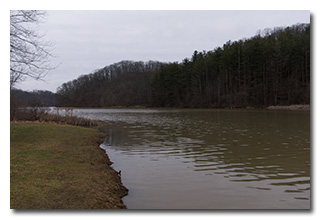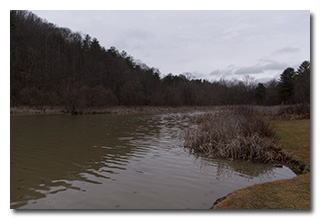
by William Eric McFadden
From the Strouds Run State Park website:
-
Strouds Run State Park is located in the scenic forested hills of Athens County, in the midst of the unglaciated Appalachian Plateau. Although untouched by the vast ice sheets that moved across portions of the state over 12,000 years ago, Strouds Run displays the effects of the glaciers -- in the deep ravines and high hills -- where the valleys served as outlets for torrents of glacial meltwaters. The erosive power of these waters carved the valleys and hillsides, creating the familiar topography Ohioans know today. Large deposits of glacial outwash, primarily sand and gravel, were deposited along these streams and strongly affected the type of biological communities present today.
Sandstone, the principal bedrock outcropping in the region, is very resistant to erosion and forms the uplands and steep sides of the valleys. Twisting roads and forest trails pass through these deep ravines and lead to dense stands of beech, hickory, oak, maple and tuliptree. Seasonal displays are offered by flowering dogwood, redbud and spring wildflowers -- with fall presenting a pageant of colorful foliage. These woods are home to white-tailed deer, fox, raccoon, opossum, squirrel, wild turkey and a variety of songbirds. Woodthrush, white-breasted nuthatch, scarlet tanager, pileated woodpecker and the rufous-sided towhee inhabit the forest canopy. These rugged hills and woodlands are truly reminiscent of the wilderness that characterized the Ohio country in the days of early settlers.
Pictures
Description
On Saturday, January 27, 2024, one member of the Southeast Ohio Radio Adventure Team performed a successful activation of Strouds Run State Park (K-1994) as part of the Parks on the Air (POTA; link) program while participating in the annual Winter Field Day (WFD) (link) field operating event.
After first helping the ACARA (link) set up for the club's WFD effort at the Jim Crouse Memorial Radio Station in the Red Cross of Southeastern Ohio chapter house (link), Eric arrived at the Bulldog Shelter at 2002 UTC to perform his own WFD operation. Despite the gray, overcast sky, the unseasonably warm temperature and lack of wind allowed Eric to comfortably operate in class 1O (one transmitter, outdoors) and Eric chose to set up his station on a picnic table in the Bulldog Shelter. For a change, Eric chose to use his Tufteln (link) 35' end-fed random wire (EFRW) antenna for this operation, deploying it as a sloper from the top of his Goture Red Fox Super Hard 720 carbon-fibermast held upright with a stake, with three 17' counterpoise wires lying directly on the ground. Eric was on the air at 2018 UTC.
Because of the need to avoid making duplicate QSOs ("dupes"), Eric had planned to log using N1MM Logger+ (link).
Eric began his operation on 20m by finding himself a clear frequency and calling "CQ WFD" and was pleased to autospotted to POTA Spots. Eric's first QSO came at 2021 UTC with N1VX in New Jersey—and here's where Eric's plan to computer-log fell apart. Because N1VX was a POTA hunter and not a participant in WFD, he sent "NJ" in his exchange. The WFD exchange requires the ARRL/RAC section be sent in the exchange, and New Jersey has two sections, "NNJ" and "SNJ", and N1MM Logger+ was smart enough to not allow Eric to save his QSO in the log with just "NJ". At this point, Eric decided to give up on computer logging, log on paper, and build an N1MM Logger+ log by hand after the event, with the proper ARRL/RAC sections.
QSOs on 20m came very quickly, with Eric's eleventh QSO coming at 2031 UTC with W2HO in New York. This run included QSOs with three WFD participants who sent the correct ARRL/RAC section in their exchange (K8ZFJ in Rhode Island; N4CD at Spring Creek Forest State Preserve, K-4423, in North Texas; and W2HO in Eastern New York) and QSOs with operators located in New Jersey, Maine, New York (2), New Hampshire, Minnesota, Georgia, Rhode Island, Texas, Connecticut, and Wisconsin.
Because WFD provides a scores-multiplier for band/mode, Eric hoped to make QSOs on all the non-WARC HF bands his antenna could cover. Toward this end, he switched to 40m, found a clear frequency, began calling "CQ WFD", and was again autospotted on POTA Spots. Eric succeeded in quickly making two QSOs, with W2GZ in New Hampshire at 2038 UTC, and with K9JAB in Indiana at 2039 UTC.
Switching to 15m, Eric found a clear frequency, began calling "CQ WFD", and was again autospotted on POTA Spots. Eric succeeded in quickly making two QSOs, with K1NEO in Maine at 2042 UTC, and with KJ7DT in Idaho at 2043 UTC.
Switching to 10m, Eric found a clear frequency, began calling "CQ WFD", and was once again autospotted on POTA Spots. After many minutes of calling CQ, Eric succeeded in making just a single QSO, with DL1OKE in Germany at 2050 UTC
Hoping for a fifth band for the multiplier, Eric switched to 80m, found a clear frequency, and began calling CQ, and autospotted to POTA Spots. Despite being spotted, many minutes of calling "CQ WFD" and "CQ POTA" failed to produce even a single QSO.
In all, Eric made sixteen QSOs on four bands in about thirty minutes of on-air time. All of Eric's QSOs were CW and were made at five watts output.
Following station tear-down, the rain started just as Eric was making his final trip to his car.
For WFD, Eric met the WFD objectives of "operate 100% on alternative power" and "operate away from home". and made sixteen QSOs, at two points per QSO for CW, with a band/mode multiplier of four, and a power multipler of two:
- 16 * 2 * 4 * 2 = 256 points
Eric also submitted his log to the World Wide Flora and Fauna in Amateur Radio (WWFF; link) program for an operation at Strouds Run State Park, KFF-1994.
(return)



